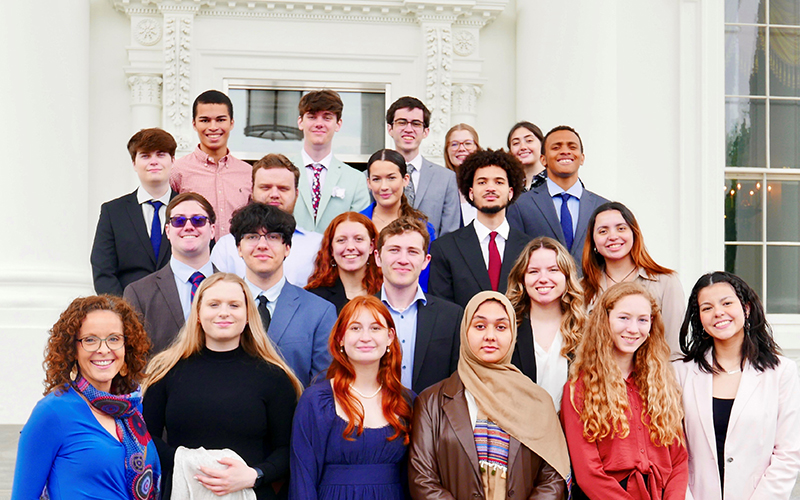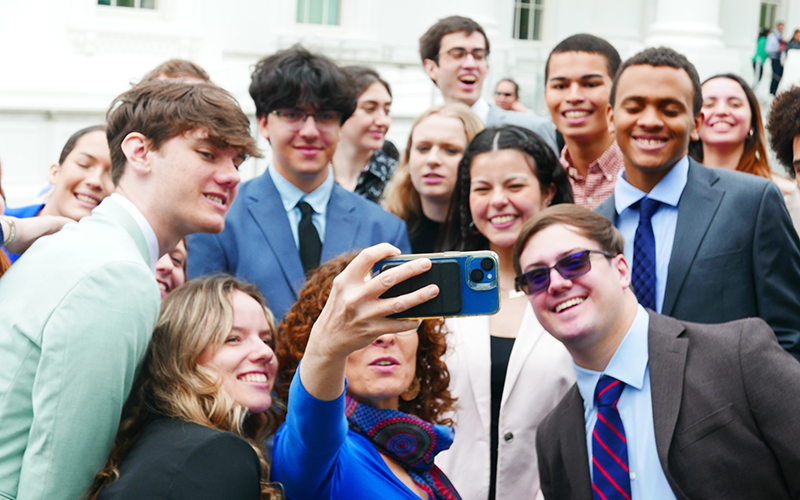In This Story


Joe Biden wasn’t home—he was campaigning in Pennsylvania—when 27 members of the Schar School of Policy and Government’s undergraduate learning community, Democracy Lab, paid a visit on Wednesday to the president’s home at 1600 Pennsylvania Avenue in northwest Washington, D.C.
The field trip to the White House, led by associate professor Jennifer N. Victor and Master of Public Policy student and learning communities assistant Mariem K. El Gazzah, was the first visit for most of the students, who are first-year government and international politics students at George Mason University.
“I think it was magical,” said Sierra Hill, originally from Gypsum, Colorado, after the self-guided tour. “Looking at the state dinner room, it made me think about the global power of the United States and how diplomacy happens right there.”
Lacey Eckert, a freshman from New Jersey, was happy to finally see the president’s house from the inside after looking at it from the other side of the wrought iron security fence several times. “But it’s a little over-hyped,” she said. “I wish we could see a little bit more, like the Oval Office, but it’s still a privilege to see inside.”
Students began the day by joining a line at the East Gate with other visitors for the multipoint security check-in before following winding corridors and eventually finding themselves inside. Surprisingly, the White House gift shop is the first room encountered. (“Isn’t the gift shop usually at the end of the ride?” one tourist commented.)
The tour continued down an East Wing corridor boasting a gallery of photos of past presidents, their families, and their pets. The Library, China Room, Green Room, Red Room, Blue Room, red velvet movie theater, and other rooms were open to look into but not enter.
Although the 45-minute tour was self-guided, Secret Service officers stationed in each room doubled as helpful docents.
“The guards were very knowledgeable about the historic paintings,” said Anastasia Rea, a native of Toledo, Ohio. “They were able to give us a lot of interesting information about where the portraits fit into American history and why they belonged in the White House.”
Like many, Jesse David Duvall was taken aback at the size of the interior of the world’s most famous private residence.
“I thought it would be a lot bigger on the inside, but it’s actually kind of small,” he said.
His key observation? The house “is actually for the president,” he said. “It’s not really meant for tourists. The main purpose of the White House is for the president and his staff. And you can see that in the operation of the house.”
Indeed, off limits to the public are the Oval Office, the Cabinet Room, the Situation Room, the James S. Brady Press Briefing Room, the Navy Mess, the Treaty Room, and most of the other 132 rooms (and 35 bathrooms) in the six-level residence.
The tour was followed by a Domino’s-catered debriefing in nearby Franklin Park.
For Hill and Rea, it was their second Schar School-sponsored visit to the White House in six months. During their first visit, Joe Biden actually was there.

